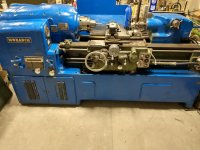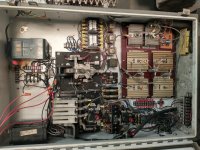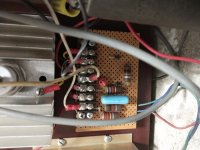Hello, this is my first post here. I need some help with my 1952 Monarch 13EE. If I am correct the lathe originally came with an AC motor to drive the spindle but now has a 7.5hp 180vdc GE Kinamatic motor with a 100/200 field. I think the motor is wired for a 200v field. I believe in the 1970's the AC motor was replaced with the DC motor. The problem is there is a transformer that has shorted out that supplies the power through a rectifier to the motor. I never measured the transformer while it still worked so I don't know what the secondary voltage was. It is 240v on the primary side of the transformer. I have tried to figure this out on my own by reading things about how to calculate the voltage output of a rectifier and I mostly understand how it works. I just don't know enough about electrical controls to really know what transformer I need. I know it is not a simple answer either. I have connected straight 240v and disconnect the motor armature and field to test the voltage. I was seeing 215v. From what I have read about rectifiers that voltage is correct without a capacitor. 240v*0.9 gives you 216. So since I was actually seeing around 245v input, with voltage drop from the diodes, that matches what I was seeing. What I think is if the motor was connected, the capacitor would actually be discharging and recharging to peak AC volts so I would be seeing around 340vdc but I don't know that to be true. There is a breadboard with some other resistor, diodes and something I don't know what is is. I don't see how 120vac supply would work because it would be around 167v with a capacitor. I hate asking for help because I can usually figure things out on my own but I have ran out of time and I need this machine running. I have contemplated just using a DC drive but everything works, I just need a new transformer. I have searched online for the same transformer in hopes that I might find some information about what the secondary voltage was but no luck. I have uploaded some pictures. I have tried to make a wire diagram but it didn't turn out that great. Sorry I couldn't get the pictures to rotate properly.[/FONT]












